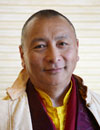
The vajrayana vow, samaya, is even more difficult to keep than the bodhisattva vow. Because the vajrayana vow of samaya is so stringent, someone who undertakes it can only achieve one of two fates. Once you take samaya you become like a snake in a vertical bamboo tube: you’re either going up, or you’re going down. You can’t sneak out the side [Rinpoche laughs]. As for the number of rules with the samaya vow, they are numbered in the hundreds of thousands.
If we consider the fundamental, most basic issue of samaya, it is your view of your guru. And if you really see your guru as the Buddha, as the dharma, as glorious Vajradhara, then you are keeping samaya. But you don’t keep samaya just by spouting this attitude; it’s not kept in your mouth. It is kept through sincere devotion. Nevertheless, because of the stringency of samaya, it becomes a very powerful vehicle. And if someone has that kind of sincere devotion, then they can achieve buddhahood in an instant through the power of that path.
Nowadays however, we live in a time of decadence, which that means we judge by externals. And therefore we pay more attention to appearances than we do to reality. Nowadays as long as a monastic, or purported monastic, knows how to put their robes on properly and wears nice-looking, impressive robes and acts the part when people can see, nobody actually seems to care of they actually keep the vows as long as they look good and don’t constitute a public disgrace.
Now I have no doubt that some monastics do keep their vows. I think there are many different situations: there are those who look good, and don’t keep them; those who look good and do keep them; and then all sorts of other possibilities as well. My point is that we judge too much by appearances.
Similarly with the bodhisattva vow, we pay more attention to the ability of a teacher to cleverly expound and enumerate the rules of the bodhisattva vow and speak with erudition about it, than we do about whether they’re in fact even keeping it in their intentions.
And similarly with vajrayana samaya, now that vajrayana has become a public matter and even a source of spectacle, there are countless individuals who dress themselves up in vajrayana costumes and ornaments and carry around the vajrayana tools and implements and ritual articles, and yet have no real samaya in their minds.
Nevertheless, in spite of the apparent dichotomy between appearances and substance, it’s still all worthwhile. Because when people take the bodhisattva vow, and even more so when they take the samaya vows, if they keep them, they might achieve buddhahood in this very life or in the bardo. But even if they don’t keep them, even in the worst possible case samsara for them will come to have an end; the end of samara for that person is guaranteed. They will have to undergo a great deal of suffering beforehand, but it will come to an end. Because when you form a connection with buddhas and bodhisattvas, that connection is unbreakable. If you form a positive connection with them, it brings quick buddhahood, but even if you form a thoroughly negative connection with them, it will ensure your future awakening.
[A teaching from Songs of Barway Dorje, Part 2, by Bardor Tulku Rinpoche. Translated by Lama Yeshe Gyamtso.]
